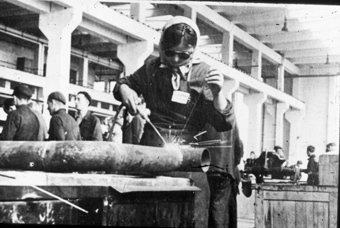East European Women as Forced Laborers for I.G. Auschwitz

© Fritz Bauer Institute (Zahn papers)
At the I.G. Auschwitz construction site, non-Jewish men and women of East European origin also were used for forced labor. This contingent included a large number of women from the German Reich-occupied territories of the Soviet Union, the Generalgouvernement, and the Ukraine Reich Commission (Reichskommissariat Ukraine). These women, called “female workers from the East” (Ostarbeiterinnen) in Nazi terminology, were, according to a directive from the Reich Labor Ministry, “from the outset, explicitly and comprehensively excluded from workplace health and safety standards, including youth and maternity protection standards.”[1] I.G. Farben plant manager Walther Dürrfeld was expecting, in January 1942, to deploy around 3,000 to 4,000 Ukrainian male and female workers at the construction site; the first groups of Ukraininan women worked there in May 1942. They were housed in Camp V – Tannenwald and forced to work in wretched conditions: even chief engineer Max Faust noticed how ill-clad the women were.
In part, those in managerial positions felt sympathy, in particular for the women; consequently, after some time, disciplinary standards for their treatment were issued to German bosses. These parameters applied especially to the camp leader of Camp V, Theodor Pillich, who reportedly was personally involved in beating up inmates on frequent occasions.[2] The Ostarbeiterinnen had to use every means possible to supplement their extremely inadequate rations; for many women, serving as prostitutes for “higher-earning” workers from the West or for Germans seemed the only way. Benedikt Kautsky even describes Buna as “an enormous brothel.”[3]
Numerous women tried to escape from this situation by running away. By August 20, 1942, of the 944 Russian and Ukraininan women deployed, 118 had taken flight. I.G. Farben imposed heavy penalties at first, but quickly realized that higher productivity on the part of the Ostarbeiterinnen was more likely to be achieved through “lenience,” and demonstrated this, for example, in September 1942 and September 1943 by buying clothing for them at a discount from the warehouses of the Auschwitz concentration camp. In October 1942, I.G. Farben introduced a piecework system, intended to exploit even more effectively the women with children who were enlisted in the most grueling excavation work.
Overall, the situation of the Ostarbeiterinnen must be described as unacceptable: They were discriminated against in the Nazi racial ideology, which also was reflected in their pay, one-third less than that of German male and female workers, and in the omission of premiums and leave. In addition, the Ostarbeiterinnen lived in their barracks as if under house arrest, as only in extremely rare cases did they receive passes allowing them to spend their scant free time outside Camp V. They were completely defenseless against the arbitrariness of their German guards, but the names of the Germans who beat them were always deleted from the records of corresponding interrogations.
Information about the liberation of the East European female forced laborers and their subsequent fate could not be obtained through research.
(SP; transl. KL)
















